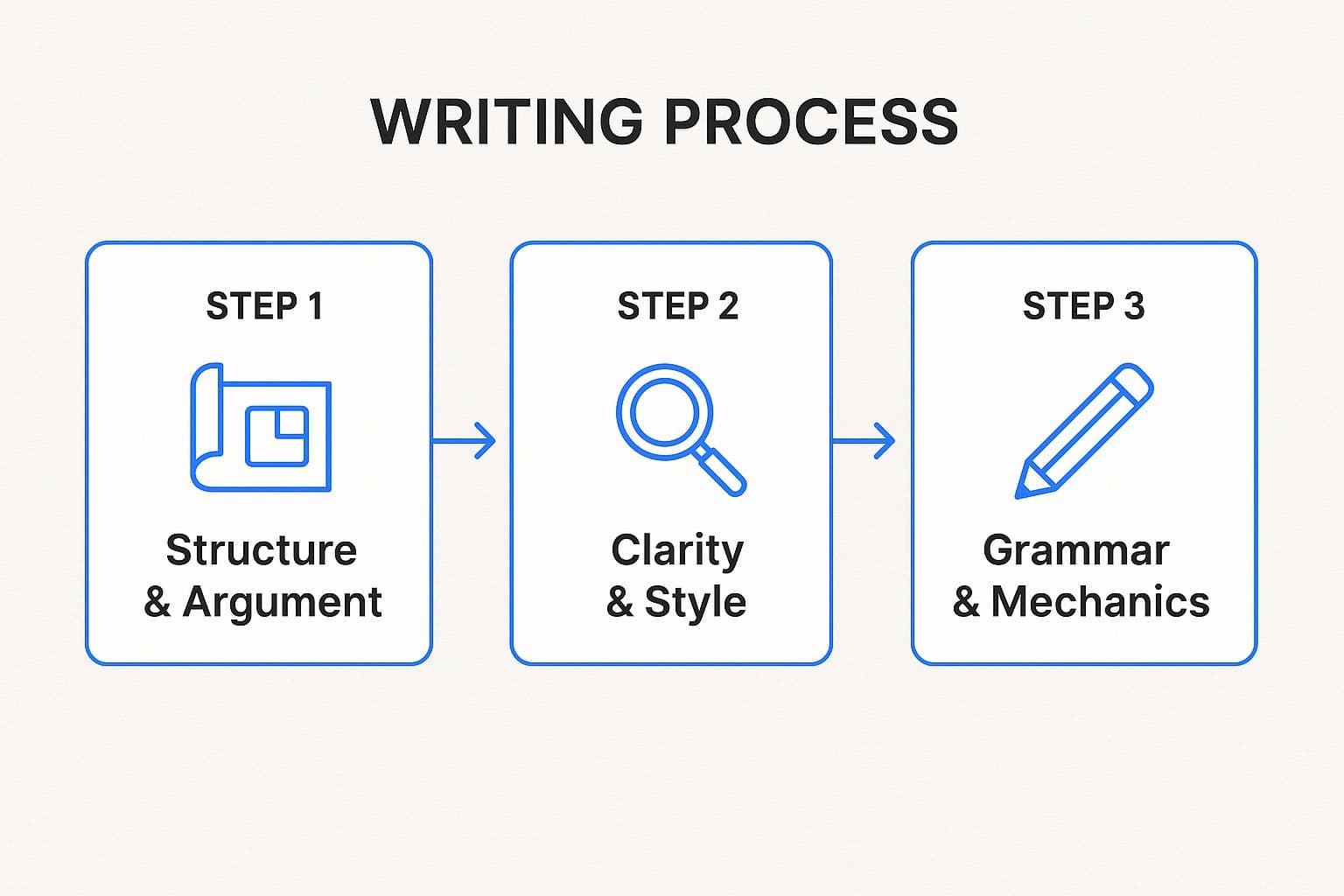7 AI-Powered Writing Revision Strategies for 2025
Discover 7 powerful writing revision strategies supercharged with AI. Learn to use text-based AI to edit faster and gain meaningful benefits in your daily life.

Writing is just the first step; revising is where your ideas truly take shape. But let's be honest, it can be a grind. Staring at your own words until they blur, wondering if your message is clear, or if your tone is right, it's exhausting. The good news? We're in a new era of productivity. Text-based AI tools, when used correctly, can transform this chore into a dynamic, insightful process. This isn't about letting a robot write for you. It's about augmenting your own skills, gaining fresh perspectives, and making every revision pass more effective.
This article breaks down seven powerful writing revision strategies and shows you how to supercharge each one with modern AI. You'll learn how to become a more efficient, confident, and productive writer in your daily life, especially when creating client-facing content, professional emails, or social media posts. To truly make revisions smarter, it's also important to have a framework for evaluating content quality effectively from a reader's perspective. Our goal is to give you actionable techniques you can apply immediately, integrating them directly into your workflow to eliminate friction and keep you in a state of flow. Let's get started.
1. Employ an AI Editing Partner for a First-Pass Triage
Before you dive headfirst into manual revisions, one of the most powerful modern writing revision strategies is to let an AI partner do the initial heavy lifting. Think of it less as a final editor and more as a tireless assistant who can instantly spot the low-hanging fruit, freeing up your brainpower for more complex, creative edits.
This "first-pass triage" involves using an AI tool to quickly scan your draft for grammatical errors, awkward phrasing, and clarity issues. It’s not about accepting every suggestion blindly; it’s about efficiently cleaning up the clutter so you can see the core message more clearly.
How to Implement AI Triage for Productivity
To get meaningful benefits from an AI assistant, use it strategically. Instead of just hitting "accept all," approach it with specific goals to maximize your productivity.
- Focus on Technicals First: Ask your AI to correct only grammar, spelling, and punctuation. A simple prompt like, "Proofread the following text for grammar and spelling errors only. Do not change the meaning or style," ensures you clean up surface-level mistakes without altering your voice.
- Prompt for Clarity and Conciseness: Once the technicals are clean, highlight a dense paragraph and use a prompt like, "Rewrite this paragraph to be more clear and concise for a business audience." This helps you spot sentences that are clunky or redundant.
- Request Alternative Phrasing: If a sentence feels weak but you can’t figure out why, highlight it and ask, "Suggest three alternative ways to phrase this sentence to make it more impactful." This can spark new ideas and help you break through a mental block.
Pro Tip: For daily productivity, use an integrated AI tool that works across all your apps (Notion, Gmail, Google Docs). This prevents constant copy-pasting and app-switching, keeping you in your creative flow and making revision a seamless part of your daily workflow.
This AI-assisted first pass is perfect for when you've just finished a "brain dump" draft. It quickly polishes the raw material, saving you the tedious task of line-by-line proofreading right away. By delegating this initial, often draining, step to AI, you preserve your mental energy for the more nuanced work of refining your argument, strengthening your narrative, and ensuring your unique voice shines through.
2. The ARRR Method (Add, Remove, Replace, Rearrange)
When a draft feels directionless or simply "off," a systematic approach can be a game-changer. The ARRR method provides a clear, four-step framework for one of the most effective writing revision strategies, turning a messy revision process into a focused, manageable task. It stands for Add, Remove, Replace, and Rearrange.
This structured method forces you to look at your draft from four distinct angles, ensuring a comprehensive edit. Instead of trying to fix everything at once, you can tackle one specific action at a time, making the revision process far less overwhelming.

How to Implement the ARRR Method with AI
Applying ARRR is about being methodical. You can supercharge this process by using AI to generate ideas for each step, boosting your productivity.
- Add: Use AI to brainstorm missing information. Prompt: "Read the following blog post. What key information or examples are missing that would make the argument more convincing for a beginner?" This helps identify gaps in your logic.
- Remove: Ask AI to hunt for fluff. Prompt: "Review this text and identify any filler words, redundant phrases, or sentences that can be removed to make it more concise."
- Replace: Leverage AI for stronger language. Highlight a sentence and ask, "Suggest three ways to replace the passive voice in this sentence with active voice," or "Find stronger verbs to replace 'is,' 'are,' 'was' in this paragraph."
- Rearrange: Get an objective opinion on flow. Prompt: "Analyze the structure of this article. Suggest a better order for the paragraphs to improve the logical flow for the reader."
Pro Tip: For daily text tasks like emails, create custom AI shortcuts for each ARRR step. For instance, a shortcut for "Replace" could automatically suggest stronger verbs for a highlighted sentence, letting you refine your message in seconds.
The ARRR method is perfect for a second draft. By combining this classic technique with targeted AI prompts, you move beyond simple error correction and critically assess your content’s structure, clarity, and impact in a fraction of the time.
3. Master the "Hot and Cold" Revision Method
One of the most effective writing revision strategies is the "Hot and Cold" method. This technique splits your editing process into two distinct phases: one immediate and intuitive ("hot"), and one detached and analytical ("cold"). It’s a powerful way to leverage both your creative momentum and your critical judgment.
The "hot" revision happens right after you finish writing, while the ideas are still fresh. The "cold" revision comes later, after you’ve stepped away from the text long enough to see it with objective eyes. This approach ensures you capture initial flashes of insight while also catching structural flaws you were too close to see before.

How to Implement Hot and Cold Revision with AI
To get meaningful benefits from this dual-phase approach, you can use AI to add structure and objectivity, especially during the "cold" phase.
- Embrace the "Hot" Edit: Immediately after finishing your draft, do a quick read-through. Fix typos and clarify confusing sentences. Use an AI tool to instantly correct grammar mistakes without slowing down your creative momentum.
- Enforce the "Cooling-Off" Period: Put the draft away for at least 24 hours. This distance is non-negotiable as it creates the psychological space needed for a true "cold" read.
- Execute the "Cold" Edit with an AI Partner: When you return, use AI as your objective third-party reader. Prompt it: "Act as a critical editor. Read the following text and provide feedback on its structure, tone, and clarity. Is the main argument clear?" This gives you an instant "cold" perspective that’s completely detached from your own bias.
Pro Tip: In your daily life, this is great for important emails. Write the draft (hot), then before sending, use an AI prompt like "Review this email. Is the tone professional and is the call to action clear?" This quick AI check serves as an instant "cold" read, preventing you from sending something written in the heat of the moment.
This strategy is ideal for substantial pieces of content. The hot phase secures your authentic voice, while the cold phase, supercharged with an AI's analytical perspective, ensures your final product is polished, professional, and clear.
4. Peer Review and Collaborative Revision
After you’ve done your initial solo pass, one of the most powerful writing revision strategies is to step outside your own head. Inviting a fresh pair of eyes to review your draft can reveal blind spots and unclear arguments.
This collaborative approach involves sharing your work with trusted peers or mentors. It’s not about surrendering your authorial control; it’s about collecting valuable data to help you see your writing from an external perspective, ensuring your message lands as intended.
How to Implement AI-Assisted Peer Review
When a human reviewer isn't available, an AI can simulate the peer review process, helping you gain new perspectives and improve your productivity.
- Simulate Different Personas: Ask the AI to act as your target reader. Prompt: "You are a busy marketing manager. Read the following article and tell me what is most and least valuable to you. What questions do you still have?" This generates specific, role-based feedback.
- Generate Guiding Questions for Human Reviewers: Use AI to prepare for a human review. Prompt: "I am sending this draft for peer review. Generate a list of 5 specific questions I can ask my reviewers to get actionable feedback on structure and clarity."
- Summarize Feedback: If you get feedback from multiple people, you can use an AI to consolidate it. Prompt: "Here is feedback from three reviewers. Summarize the main points of agreement and disagreement." This helps you spot patterns and prioritize revisions.
Pro Tip: For daily productivity, you can create a custom "AI Persona" command. For example, a "Cynical Customer" persona that you can run on your marketing copy to instantly check for weak claims or confusing language. This makes your text more robust before it ever reaches a real person.
This strategy is best used after you've completed your self-editing passes. By using AI to simulate or prepare for peer review, you can elevate a good piece of writing to a great one, ensuring it resonates deeply with your audience.
5. The SPA Method (Structure, Purpose, Audience)
After cleaning up your draft, it's time to zoom out. The SPA Method is one of the most effective writing revision strategies for ensuring your entire piece is fundamentally sound. It forces you to evaluate your work through three critical lenses: Structure, Purpose, and Audience.
This framework moves you beyond grammar and word choice to address the core architecture of your writing. By systematically checking that your document's organization (Structure), its core goal (Purpose), and its intended reader (Audience) are all in perfect alignment, you ensure your message doesn't just sound good, it actually works.
How to Implement the SPA Method with AI
Applying this method involves asking targeted questions for each pillar. AI can act as an invaluable sounding board to check your alignment and boost your productivity.
- Clarify Your Purpose: Use AI to check if your purpose is being met. Prompt: "The goal of this text is to convince readers to sign up for a free trial. Does it achieve this? If not, what should be changed?"
- Define Your Audience: Have the AI evaluate your writing for a specific audience. Prompt: "Is the language and tone of this text appropriate for a beginner with no technical knowledge? Suggest changes to make it more accessible."
- Analyze Your Structure: Let AI reverse-outline your draft to check its structure. Prompt: "Create a bulleted outline of the main arguments in this text. Does the structure flow logically?" This instantly reveals structural weaknesses.
Pro Tip: Save your SPA prompts as custom AI commands. For any important document, you can run a "SPA Check" that asks the AI to analyze your text for purpose, audience, and structure in one go, providing a comprehensive report in seconds. This is a massive productivity gain for daily work.
The SPA method is invaluable for high-stakes documents like business proposals or marketing campaigns. Using AI to automate the analysis transforms revision into a strategic process, guaranteeing that your final piece is not only polished but also powerful and persuasive.
6. Read-Aloud Revision: Let Your Ears Do the Editing
After you’ve stared at a draft for hours, your eyes start playing tricks on you. One of the most effective writing revision strategies to combat this is to switch senses. By reading your work aloud, you engage your auditory processing, revealing issues your eyes completely miss.
This technique is about hearing your words as a reader would. It instantly exposes clunky sentences, poor rhythm, and unnatural dialogue that look perfectly fine on the page.
How to Implement AI-Assisted Read-Aloud Revision
To make this more than just mumbling to yourself, you can use technology to enhance the experience and gain a more objective perspective, boosting productivity.
- Use a Text-to-Speech (TTS) Tool: The most productive way to use this method is with a text-to-speech reader, which many AI tools have built-in. Hearing a neutral, robotic voice read your text is incredibly effective. Any sentence that sounds awkward or confusing when read by the AI needs to be revised for clarity.
- Listen at Different Speeds: Play the audio back at 1.25x or 1.5x speed. This can help you catch parts that drag or where the flow is clunky. If it's hard to follow at a faster speed, it might be overly complex.
- Focus on Pauses: Pay attention to where the AI voice pauses. Does it align with your punctuation? If the AI reads a sentence in a weird rhythm, it’s a sign that your commas or sentence structure might need work.
Pro Tip: This is a fantastic productivity hack for daily tasks. Before hitting "send" on an important email or posting on social media, use your AI tool’s text-to-speech function for a quick 30-second listen. It's the fastest way to catch embarrassing typos or awkward phrases.
The read-aloud method is perfect for a final pass. It’s particularly powerful for creators whose text needs a conversational, authentic tone. By letting an AI do the reading, you free yourself up to simply listen, ensuring your words connect on a human level.
7. Layer-by-Layer Revision
Trying to fix everything at once is a recipe for overwhelming yourself. A far more effective approach is to revise in layers. This is one of the most powerful professional writing revision strategies, treating your draft like a painting where you work on different elements in separate passes.
This systematic process involves tackling distinct aspects of your writing one at a time. You might do a first pass focused only on structure, a second on clarity, and a final pass for grammar. This ensures each element gets your full attention.
How to Implement a Layered Revision with AI
Adopting this methodical approach with AI transforms revision from a chaotic mess into a manageable, highly productive project.
- Layer 1: The Blueprint (Structure & Argument): Use an AI prompt focused only on the big picture. "Analyze the overall argument of this text. Is it logical and well-supported? Ignore grammar." This keeps the feedback high-level.
- Layer 2: The Flow (Clarity & Conciseness): In this pass, use a different prompt. "Review each paragraph for clarity and flow. Suggest rewrites for any confusing sentences. Do not correct spelling." This zooms in on sentence-level issues.
- Layer 3: The Polish (Grammar & Mechanics): This is the final, automated stage. Use your AI's proofreading function to hunt down typos, grammatical errors, and punctuation mistakes. This is where you let the AI handle the fine-toothed-comb work.
Pro Tip: Create a set of custom AI commands named "Layer 1," "Layer 2," and "Layer 3," each with a specific prompt. For any draft, you can run these commands sequentially, giving you a structured, professional editing workflow that you can execute in minutes.
The following infographic illustrates this structured, step-by-step revision workflow.

This visual process flow highlights the importance of starting with the biggest architectural issues before moving to the smaller details. By tackling structural problems first, you avoid wasting time polishing sentences that might be cut later. By using AI to assist each layer, you can learn how to write more efficiently and produce a much stronger final piece.
Writing Revision Strategies Comparison
| Method | 🔄 Implementation Complexity | ⚡ Resource Requirements | 📊 Expected Outcomes | 💡 Ideal Use Cases | ⭐ Key Advantages |
|---|---|---|---|---|---|
| AI First-Pass Triage | Low (simple prompts, integrated tools) | Low (AI tool subscription) | Quick cleanup of surface errors, saves time | Daily emails, first drafts, social media posts | Boosts productivity; conserves mental energy |
| The ARRR Method (Add, Remove, Replace, Rearrange) | Moderate (systematic four-step process) | Low to Moderate (AI tool for suggestions) | Comprehensive content refinement | Novice writers, multi-level revision | Covers all revision aspects; AI speeds up process |
| Hot and Cold Revision | Moderate (requires timing and planning) | Low (time intervals, AI for cold read) | Balanced creative and critical revisions | Important reports, blog posts, creative writing | Enhances perspective; AI provides instant objectivity |
| AI-Assisted Peer Review | Moderate (crafting personas and prompts) | Low (AI tool) | Diverse insights, audience alignment check | Marketing copy, user-facing documents | Instant feedback; simulates target audience |
| The SPA Method (Structure, Purpose, Audience) | Moderate (analytical evaluation) | Low (AI for analysis) | Alignment of writing goals with reader needs | Professional and academic writing | Holistic focus; AI validates strategic alignment |
| AI-Powered Read-Aloud Revision | Low (using text-to-speech features) | Low (AI tool with TTS) | Improved rhythm, clarity, and voice consistency | Speeches, dialogue, conversational content | Reveals awkward phrasing; highly efficient |
| Layer-by-Layer Revision | High (multiple focused revision passes) | Moderate (AI for each layer) | Thorough, hierarchical improvement from macro to micro | Detailed editing in professional or complex projects | Prevents overwhelm; ensures comprehensive coverage |
From Revision to Results: Your New AI-Assisted Workflow
And there you have it—a complete toolkit of powerful writing revision strategies designed to elevate your work with the help of AI. We've journeyed through classic techniques supercharged for modern productivity. From using an AI to perform a quick First-Pass Triage on an email to a deep, Layer-by-Layer analysis of a major report, these are practical, actionable frameworks you can implement today.
Remember, the goal isn't to apply every single strategy to every piece of text. The real power lies in building your own personalized, AI-assisted revision system. Think of these strategies as apps on your phone. Sometimes you need a quick "Proofread" app. Other times, you need the "Analyze Structure" app.
Integrating AI for Meaningful Productivity Gains
The true game-changer for daily productivity is knowing how to command your AI efficiently. This is where AI transforms from a fun tool into an indispensable partner for anyone who works with text. By creating custom AI commands based on these strategies, you can automate the most tedious parts of revision.
Imagine this for your daily tasks:
- Writing an email: Instead of rereading it five times, you use a single AI command: "Make this email more concise and professional."
- Posting on social media: Instead of guessing if it's engaging, you ask your AI: "Rewrite this post to be more engaging for a LinkedIn audience."
- Finishing a report: Instead of reading it aloud yourself, you have an AI read it back to you, freeing you up to just listen for flow and awkward phrasing.
This AI-assisted approach doesn't replace your critical thinking; it supercharges it. It handles the heavy lifting, allowing you to focus on the high-level decisions that truly matter. You're no longer just a writer; you're the director of a sophisticated, AI-powered editing process. To further explore how AI can streamline your entire content workflow, consider integrating the top AI tools for content creators into your process.
Mastering these writing revision strategies with AI is about more than just cleaner copy. It’s about building confidence, saving precious hours, and ensuring your message connects with your audience exactly as you intended. By weaving these methods into a modern, AI-enhanced workflow, you create a sustainable system for producing high-quality work, consistently and without the burnout.
Ready to stop switching tabs and start revising smarter? TypeBoost integrates directly into any app you use, allowing you to save these revision strategies as custom commands and execute them with a simple shortcut. Try TypeBoost for free and turn your revision process from a chore into a strategic advantage.